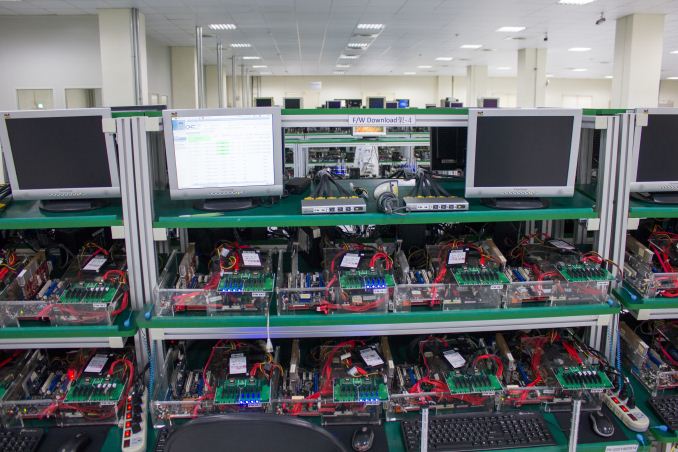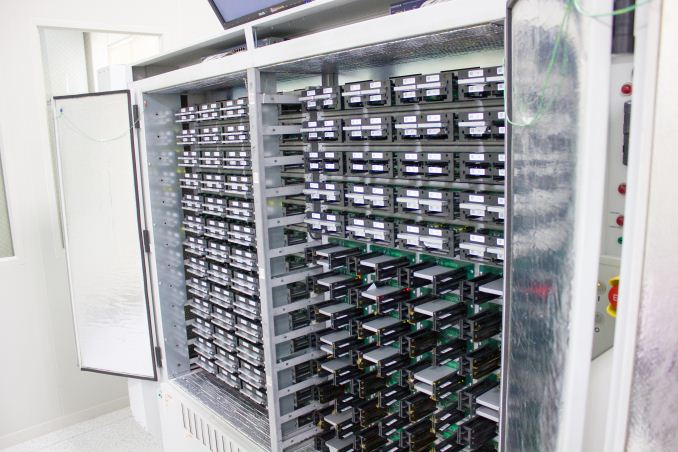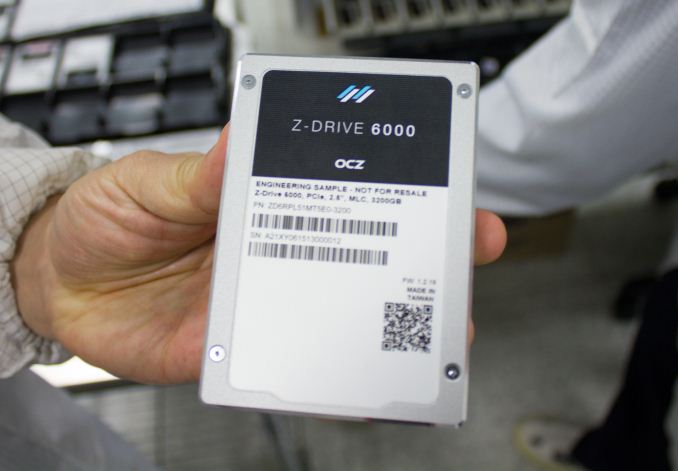Inside OCZ's Factory: How SSDs Are Made
by Kristian Vättö on May 20, 2015 8:30 AM ESTFirmware Installation
Now that the hardware side of the drive is ready, it's time to put some intelligence (the firmware) inside.
The firmware download is done by custom PC setups that consist of normal PC hardware (if you look closely, you can see ASUS' logo on a motherboard or two) running some sort of a Linux distro with OCZ's custom firmware download tool. If you zoom into the monitor you can see that in this case the system is applying firmware to 240GB ARC100 drives.
Once the firmware has been loaded, the drives will move to run-in testing. OCZ has developed a custom script that writes and reads all LBAs eight times with the purpose of identifying bad blocks. If a drive has more bad blocks than a preset threshold allows, it will be pulled away and either fixed or destroyed. The scripts also test performance using common benchmarking tools (e.g. AS-SSD and ATTO) to ensure that all drives meet the spec.
Currently OCZ has two different test setups. One half of the test systems are regular PCs that are very similar to the firmware download systems, whereas the other half are custom racks pictured above. OCZ is looking to move all testing to rack-based cabins since one cabin can simultaneously test 256 drives, which is far more efficient than having dozens of PC setups around that can only test a handful of drives each at a time. The test regime is the same in both cases, so it's purely a matter of space and labor efficiency.
At the moment SATA based drives are tested through the host, which means that the IO commands are sent by the host similar to how we test SSDs. For PCIe drives, however, OCZ is developing a Manufacturing Self Test (MST) that is essentially a custom firmware that is loaded into the drive, which then reads and writes all LBAs to test for bad blocks. The benefit of MST is the fact that it bypasses the host interface (i.e. all IO commands are generated by the controller/firmware), making the test cycle faster as the host overhead is removed.
Additionally, every month a sample of finished drives go through a more rigid tests called Ongoing Reliability Testing (ORT) to ensure that nothing has changed in production quality. The tests consist of Thermal Cycle Test (TCT) where the drive is subjected to thermal shocks to validate the quality of manufacturing and Reliability Demonstration Test (RDT) where drives are tested at elevated temperature (~70°C) to demonstrate that the mean time before failure (MTBF) meets the specification.
The run-in testing hasn't changed much since Toshiba took over, but Toshiba did help OCZ to align to its quality standards. All the processes running today have been inspected by Toshiba and meet the strict standards set by the company. Note that the purpose of run-in testing isn't to screen for firmware bugs, but to ensure that the hardware is functional. The firmware development and validation is done before the mass production begins and after Toshiba took over OCZ has modified its development process to increase the quality and reliability of its products.
OCZ's whole philosophy has actually changed since the previous CEO left the company because in the past OCZ always tried to be the first to the market at any cost and tried to cover every possible micro-niche, which resulted in too many product lines for the resources OCZ had. Nowadays OCZ is putting a lot of effort into product qualification and it no longer has a dozen products in development at the same time, meaning that there's now sufficient resources to properly validate every product before it enters mass production.
The run-in testing may seem light with only eight full LBA read/write spans, but honestly I don't think it's necessary to hammer a drive for days because any apparent hardware flaw should surface very quickly. Basically, the hardware either works or it doesn't, and once the drive leaves the factory it's more likely to fail due to firmware anomaly than a physical hardware failure.













64 Comments
View All Comments
Murloc - Wednesday, May 20, 2015 - link
lol come on they visited other factories too....This article is neutral.
jihe - Wednesday, May 20, 2015 - link
You forgot Step 0 in the process: stockpile C-grade discarded nand chips from Micron/Intel/Samsung.valinor89 - Wednesday, May 20, 2015 - link
The point of being owned by Toshiba is precisely to avoid having to do that.ocz_tuff_bunny - Wednesday, May 20, 2015 - link
Hi jihe,Since this is my first comment in regards to this article please allow me to identify myself as an OCZ representative. Thank you for your comment. Being apart of a Toshiba Group Company all of our drives leverage premium Toshiba NAND. In the past few years we made significant upgrades in our products and processes to improve quality and continue to make investments in this area.
sor - Thursday, May 21, 2015 - link
This would surprise me. I've worked for memory manufacturers in the past, and you'll often find Samsung chips on Micron memory modules, and vice versa, simply because a company might choose to sell their die into more lucrative channels, or focus on manufacturing more lucrative configurations, or fulfill more lucrative contracts with the capacity they have. Then they supplement with product from competing manufacturers on their own products. People who pay attention to such things are occasionally surprised to see it, but in business its the bottom line that counts, and if you can make $.50 more per part by putting a configuration that you don't need internally on your wafers, and source your internal needs cheaper elsewhere, then you do it.Kristian Vättö - Thursday, May 21, 2015 - link
In the DRAM industry it's true that the original manufacturer of the chips varies more, but on the other hand nobody claims to use brand X chips in their modules (it's always just the speed and latency that are reported). In SSDs it's different as manufacturers specifically state what NAND they use, so switching from one NAND to another would be misleading marketing (and we've had some do that in the past, which lead to ugly results). Another thing is that SSD performance depends highly on NAND, so switching the chips inside would lead to varying performance unlike in DRAM.jihe - Thursday, May 21, 2015 - link
Well, will you promise to use Grade A Toshiba NANDs only then? Because OCZ had been one of the worse offenders of switching to terrible NAND chips in their SSD's, often within the same model and without any disclosure to the consumer. I would go as far as saying OCZ were using bait and switch tactics. Given your history it would take a lot to sway public sentiment. Perhaps having a NAND chip guarantee would go some way in correcting that.dgingeri - Wednesday, May 20, 2015 - link
I'm quite surprised by their firmware install process. I thought it would be more automated and part of the QA process. I also thought they would have automated the stickers long before now.Wwhat - Wednesday, May 20, 2015 - link
Many factories have such a weird final hand-done step. I think it's just so people have a job.And although that's fine, I think it does show the flaws in the capitalist system and the society's thinking.
jimjamjamie - Wednesday, May 20, 2015 - link
"..running some sort of a Linux distro.."If you zoom in on the photo you can see that the applications menu button (top left) has a Fedora logo. Interesting choice!